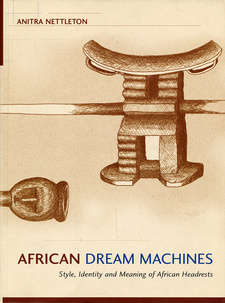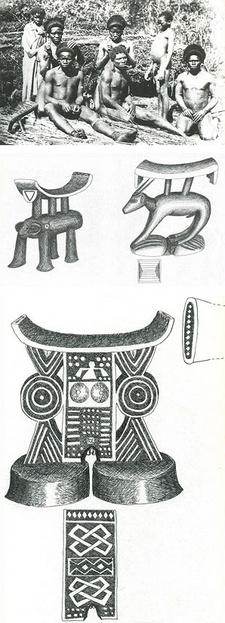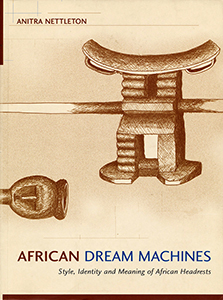African Dream Machines. Style, Identity and Meaning of African Headrests, by Anitra Nettleton

African Dream Machines: Style, Identity and Meaning of African Headrests, by Anitra Nettleton. Witwatersrand University Press. Johannesburg, 2008. ISBN 9781868144587 / ISBN 978-1-86814-458-7

Imgages taken from the book African Dream Machines (Anitra Nettleton; ISBN 9781868144587 / ISBN 978-1-86814-458-7)
Anitra Nettleton's book, African Dream Machines: Style, Identity and Meaning of African Headrests' has been in the making for a total of fifteen years. The research started with my PhD on the traditional woodcarving of the Shona- and Venda-speaking peoples of Zimbabwe and South Africa.
Among the artefacts made by Southern African peoples, headrests were the best known, and they formed the centre of what I was to write about the art of the Shona. I spent a year in Europe in 1975-1976 researching all forms of woodcarving among Southern African peoples and discovered museum stores full of unacknowledged 'masterpieces' made by speakers of numerous Southern African languages. Many of these were headrests. In investigating headrests closely, I became aware of contexts of use and distributions of form which allowed me to use headrests to investigate a number of problems that face anyone who wishes to use art-historical methodologies to understand form, style and content in African art objects. A Council Fellowship from the University of the Witwatersrand in 1990 to 1991 enabled me to hunt down more headrests from across the African continent held in museum collections across Europe, and to develop an archive in the form of notes on, and photographs and sketches of each headrest I encountered. Where I was permitted, I also consulted museum registers for histories of these objects and made notes on that material in order to establish a particular context for each. Armed with this research I returned home to begin its compilation, and began the process of drawing every headrest which I intended to illustrate in the book. Some of the drawings were made between 1980 and 1983, as illustrations for my PhD thesis, but the vast majority were executed between 1992 and 2005. Many examples from South African collections were added at this time, expanding the field vastly. Initially I started the drawings because I was obstructed from taking photographs in two museums, once in Zimbabwe in 1981, and once in Belgium in 1991. However, I soon discovered that drawings enabled me to present information that would have been completely impossible with single views of each object such as those offered by the conventional face-view photograph. The process of drawing then became a tool of analysis as much as it was a means of presenting visual information. So, while the drawings started out as mere accompaniments to a text whose research dimension was vast, they have become a major part of the project in their own right. The text in this book examines objects whose functional utility might, in the past, have prevented them from being taken seriously as forms of art. The book therefore starts with a chapter which examines the processes whereby such objects have been incorporated into a discourse of aesthetics and meaning and thus of 'art'. That is followed by a chapter in which the notion of 'style' is interrogated in relation to a single, albeit contested, 'ethnic' group, the Tellem. Chapter three of African Dream Machines. Style, Identity and Meaning of African Headrests is a short explanation of methodological issues underlying the research and the use of the drawings. In the next two chapters I track the distribution of a single form of headrest, those which use single or multiple columns as supports, across the continent and across time on the continent, and in the process I trace similarities among widely dispersed forms. This distribution study is also used to challenge notions of 'authenticity'. I then turn to discussing headrests in regional categories, starting with East Africa, looking mostly at forms made by people speaking Cushitic and Nilotic languages. The following chapter looks at headrest forms made by Bantu speakers, which are quite different from those made by the East African groups and which are tracked here in relation to histories of collection and marketing. [...]
This is an excerpt from African Dream Machines. Style, Identity and Meaning of African Headrests, by Anitra Nettleton.
Title: African Dream Machines
Subtitle: Style, Identity and Meaning of African Headrests
Author: Anitra Nettleton
Publisher: Witwatersrand University Press
Johannesburg, 2008
ISBN 9781868144587 / ISBN 978-1-86814-458-7
Softcover, 17 x 24 cm, 352 pages, many bw-illustrations
Nettleton, Anitra im Namibiana-Buchangebot
African Dream Machines. Style, Identity and Meaning of African Headrests
African Dream Machines. Style, Identity and Meaning of African Headrests discusses the assumed one-to-one relationship between formal styles and ethnic identities or classifications.

